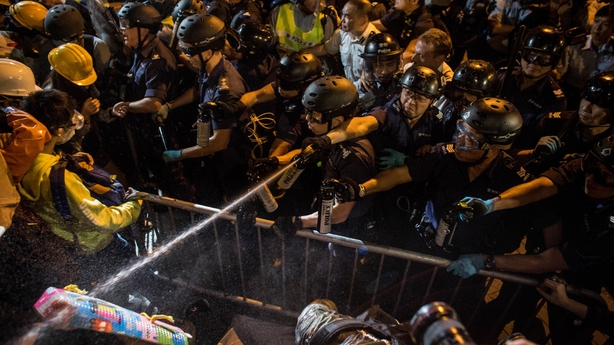After two months of pro-democracy rallies, Hong Kong police moved in to clear tents and barricades.
Timeline of key dates in Hong Kong's pro-democracy movement.
10 June: Beijing issues a "White Paper" on Hong Kong that -- according to democracy campaigners -- shows that the city's much-cherished freedoms could be revoked at any time.
30 June: 800,000 people vote in favour of greater democratic freedoms than Beijing has proposed in an unofficial referendum organised by the protest group Occupy Central.
31 August: China insists on its right to vet candidates for Hong Kong's next leadership elections in 2017. In response, Occupy Central and other groups vow to embark on an "era of civil disobedience" including mass sit-ins.
22 September: University students begin a week-long boycott of classes. Around 150 student protesters storm government headquarters four days later and occupy a courtyard in the complex. Police use pepper spray to repel them. The protesters defend themselves with their now emblematic umbrellas.
28 September: With parts of the government complex besieged, Occupy Central joins the students announcing it has begun its civil disobedience campaign. A major street opposite government headquarters is taken over by protesters. In response riot officers fire tear gas and crowd numbers swell as anger mounts over the police action.

3 October: Student leaders agree to Hong Kong leader CY Leung's offer of talks. But chaos later erupts in Mong Kok, a busy working-class shopping district taken over by protesters, when government loyalist thugs attack demonstrators. Student leaders call off talks a day later, accusing police of failing to act over violent attacks against them.
6 October: Protest numbers dwindle but demonstrators remain in control of barricades across the city. Protest leaders agree to a resumption of talks, but they collapse day later as the government pulls out.
21 October: Leung is criticised for telling foreign media that free elections would result in the poor dominating the city's politics. Talks between protesters and the government resume but no progress is made.
15 November: Three student protesters are stopped from travelling to Beijing, where they had planned to seek talks with Chinese authorities.
18 November: Protesters attempt to storm Hong Kong's parliament, triggering clashes with police, as court-ordered clearances get underway.
26 November: Hundreds of police clear a protest site in the Mong Kok district and reopen a main road.
30 November: Police use pepper spray to fend off hundreds of demonstrators trying to surround the government headquarters, with clashes spilling into the following day. Student leaders including Joshua Wong, the teenage demonstrator who has become one of the faces of the protest movement, announce a hunger strike, which Wong ends four days later.

11 December: Hong Kong police dismantle the city's main pro-democracy site, clearing away tents and barricades after more than two months of rallies, and hauling off a hard core of protesters who nevertheless vow that their struggle lives on.

